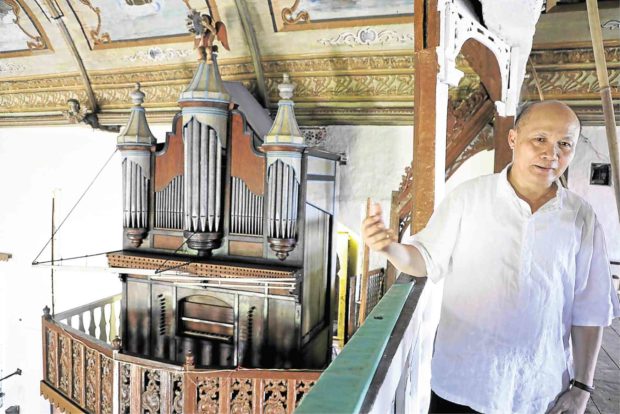After 40 years, Argao folk hear shrine’s pipe organ play again

Monsignor Camilo Alia is instrumental in the restoration of the ancient pipe organ that has been silent for four decades.—TONEE DESPOJO/CEBU DAILY NEWS
ARGAO, Cebu — For four decades, Charissa Mae Sarchez has been wanting to hear the sound of the pipe organ she has been seeing at the Archdiocesan Shrine of St. Michael the Archangel in this town.
“I’m now 42 years old and yet I have not heard even its minutest sound,” said Sarchez, a pianist whose grandmother used to play the custom-made organ at the historic church.
But 40 years of anticipation and prayerful waiting will end on Saturday as the newly refurbished pipe organ is played in a concert inside the Spanish-era church.
The organ was fixed on the request of the priests assigned to the shrine, which was damaged by a 7.2-magnitude earthquake that rocked the provinces of Cebu and Bohol in October 2013.
Just as restoration works were done to repair portions of the church, local priests in 2014 asked the National Historical Commission of the Philippines (NHCP) to also repair its pipe organ which sat idle on the church’s side balcony for 40 years.
According to Msgr. Camilo Alia, moderator of the shrine’s team of pastors, it is necessary to restore Argao’s pipe organ because it is an enduring symbol of Cebu’s culture, history and heritage.
“The pipe organ is very significant, and restoring it was badly needed,” he told the Inquirer.
Restoration
The stringent process of restoring the pipe organ began in 2015 under the supervision of the NHCP.
The NHCP, in collaboration with the Department of Tourism, spent at least P4 million for the restoration of Argao’s pipe organ, which was estimated to have been installed in the 1800s by Padre Diego Cera, an Augustinian Recollect priest from Graus, Spain.
The Diego Cera Organ Builders Inc., curator of the world-famous bamboo organ of Las Piñas City in Metro Manila, was commissioned to lead the restoration.
“There were pipes that needed to be replaced, so new pipes from Las Piñas had to be shipped to Cebu piece by piece. They also had to replace the actual keyboard,” Alia said.
Fr. Brian Brigoli, chair of Cebu Archdiocesan Commission on Culture and Heritage, said the musical instrument in Argao was one of the three pipe organs in Cebu dating back to the Spanish colonial period.
The two others are found in the towns of Dalaguete and Boljoon.
Two bigger pipe organs were also installed at Basilica Minore del Sto. Niño in 1965, and at Cebu Metropolitan Cathedral in 1996.
“The pipe organ in Argao is the oldest. We have no records yet as to when it was constructed. But there is a big possibility that it was installed sometime in the 1800s,” Brigoli said.
Argao church’s pipe organ has 700 pipes with 22 different timbres that provide a variety of sounds, depending on the preference of the person who plays it.
It was described by professional organ makers as having “windchests constructed from a massive solid wood,” and has similarities with the casework of the pipe organ of the San Agustin Church in Intramuros, Manila.
The pipe organ produces sound by driving pressurized air through organ pipes selected through the keyboard and a pedal board.
‘Petot’
On top of the musical instrument is an image of an angel carrying a “rueda” (bell wheel). Argaoanons, by tradition, call the cherub “Petot.”
Alia said the pipe organ was the last structure restored by the NHCP in Argao, next to the town’s church façade, paintings, museum and retablo or main altar.
Records of the Archdiocese of Cebu showed that coral stone church was built by Augustinian missionaries in 1788. A wooden retablo intricately covered with gilding or gold paint dominates the altar section. Originally, all religious images were wooden polychrome or painted in various colors.
But in the mid-2000, the images of the archangels Michael, Rafael and Gabriel, and the Immaculate Conception were all gilded in gold by the then parish priest, thus obliterating the original “estofado” designs and patterns.
Early this year, Alia said they decided to request the NHCP to restore the original paintings of the sacred images on the request of Argaoanons.
It took about five months for the NHCP to bring back the original designs of the centuries-old archangels, and the Blessed Virgin Mary.
Alia, who was assigned in Argao in 2014, said parishioners and the clergy in the town were happy to bring back the glory of the church and everything in it.
“A lot of structures here underwent restoration. I’m just happy that we now have back what we longed for. The sacred images are restored to their original design, and the pipe organ is finally usable after 40 years. To God be all thanksgiving,” he said.














